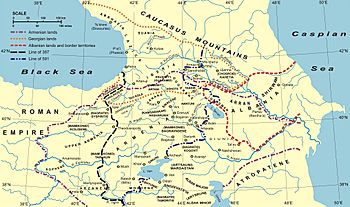Caucasian Albania facts for kids
Quick facts for kids
Caucasian Albania
|
|||||||||
|---|---|---|---|---|---|---|---|---|---|
| 4th century BC – 8th century AD | |||||||||

Borders of Arsacid kingdom Caucasian Albania (late 4th century) in the Sassanid empie
|
|||||||||
| Capital | Kabalak, Partav | ||||||||
| Common languages | Caucasian Albanian, Armenian, Parthian language, Middle Persian | ||||||||
| Religion | Paganism, Christianity, Zoroastrianism | ||||||||
| Historical era | Antiquity | ||||||||
|
• Established
|
4th century BC | ||||||||
|
• Disestablished
|
8th century | ||||||||
|
|||||||||
| Today part of | |||||||||
Caucasian Albania was an ancient country located in the eastern Caucasus region. It's called 'Caucasian Albania' to avoid confusion with the modern country of Albania in Europe. This historical land was mostly where Azerbaijan is today, and also parts of southern Dagestan. We don't know what the people who lived there called their own country.
Contents
What Was Caucasian Albania?
Caucasian Albania was a kingdom that existed for over a thousand years. It was an important part of the ancient world in the Caucasus. This region is a bridge between Europe and Asia. Many different cultures and empires met and sometimes clashed here.
Where Was It Located?
Caucasian Albania was in the eastern part of the Caucasus mountains. Its lands stretched from the Greater Caucasus mountains in the north to the Aras River in the south. The Caspian Sea formed its eastern border. This location made it a key area for trade and travel between different parts of the ancient world.
A Long History
The history of Caucasian Albania is long and full of changes. It saw the rise and fall of many powerful empires around it.
Early Beginnings
Caucasian Albania first appeared as a kingdom around the 4th century BC. Before that, the area was likely home to many different tribes. These tribes eventually came together to form a more organized state. They were often influenced by the larger empires nearby.
Under Big Empires
For much of its history, Caucasian Albania was often a vassal state. This means it was a kingdom that had its own ruler but was also under the control of a more powerful empire.
- Parthian Empire: For a long time, Caucasian Albania was linked to the Parthian Empire. This empire was a major power in ancient Iran.
- Roman Empire: Sometimes, Caucasian Albania also had ties with the mighty Roman Empire. The Romans were very active in the Caucasus region.
- Sasanian Empire: Later, the Sasanian Empire (another powerful Persian empire) took over from the Parthians. Caucasian Albania became an important part of the Sasanian world. The Sasanians often appointed their own governors or kings to rule the region.
The Rise of Christianity
In the 4th century AD, Christianity became the official religion of Caucasian Albania. This happened around the same time as in neighboring Armenia and Georgia. Churches and monasteries were built, and the new faith spread throughout the land. This was a very important change for the people and their culture.
The End of Caucasian Albania
The kingdom of Caucasian Albania came to an end in the 8th century AD. This happened when the Rashidun Caliphate, a powerful Islamic empire, expanded into the Caucasus. The region became part of the larger Islamic world. Over time, the unique culture and language of Caucasian Albania slowly faded away.
Daily Life and Culture
Life in Caucasian Albania involved a mix of different cultures and beliefs.
Languages and Beliefs
The main language spoken was Caucasian Albanian. This language was part of a group of languages unique to the Caucasus. People also spoke Armenian, Parthian language, and Middle Persian due to the influence of neighboring empires. Before Christianity, people practiced Paganism, worshiping many gods. Later, Zoroastrianism, an ancient Persian religion, also had an influence before Christianity became dominant.
Important Cities
Caucasian Albania had several important cities. Its first capital was Kabalak. Later, the capital moved to Partav. These cities were centers for trade, government, and culture. They had impressive buildings and defenses.
Images for kids
-
A column capital with an Albanian inscription from a 7th-century church in Mingachevir (Azerbaijan State Museum of History).
See also
 In Spanish: Albania caucásica para niños
In Spanish: Albania caucásica para niños







